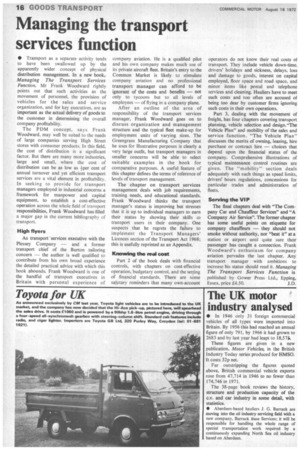Managing the transport services function
Page 18

If you've noticed an error in this article please click here to report it so we can fix it.
• Transport as a separate activity tends to have been swallowed up by the apparently wider concept of physical distribution management. In a new book, Managing The Transport Services Function, Mr Frank Woodward rightly points out that such activities as the movement of personnel, the provision of vehicles for the sales and service organization, and for key executives, are as important as the actual delivery of goods to the customer in determining the overall company profitability.
The PDM concept, says Frank Woodward, may well be suited to the needs of large companies serving High Street stores with consumer products. In this field, the cost of distribution is a significant factor. But there are many more industries, large and small, where the cost of distribution can be as low as -I-per cent of annual turnover and yet efficient transport services are a vital element in profitability. In seeking to provide for transport managers employed in industrial concerns a framework for manpower and capital equipment, to establish a cost-effective operation across the whole field of transport responsibilities, Frank Woodward has filled a major gap in the current bibliography of transport.
High flyers As transport -services executive with the Plessey Company — and a former transport chief of the Burton tailoring concern — the author is well qualified to contribute from his own broad experience the detailed practical advice with which this book abounds. Frank Woodward is one of the handful of transport executives in Britain with personal experience of
company aviation. He is a qualified pilot and his own company makes much use of its private aircraft fleet. Britain's entry to the Common Market is likely to stimulate company aviation and no professional transport manager can afford to be ignorant of the costs and benefits — not only to tycoons but to all levels of employees — of flying in a company plane.
After an outline of the area of responsibility of the transport services manager, Frank Woodward goes on to discuss organization and management structure and the typical fleet make-up for employment units of varying sizes. The Greengrass Manufacturing Company that he uses for illustrative purposes is clearly a very large outfit, but transport managers in smaller concerns will be able to select suitable examples in the book for comparative purposes. A useful feature of this chapter defines the terms of reference of levels of transport management.
The chapter on transport services management deals with job requirements, training needs, and educational standards. Frank Woodward thinks the transport manager's status is improving but stresses that it is up to individual managers to earn their status by showing their skills Lo transport users in their company. One suspects that he regrets the failure to implement the Transport Managers' Licences section of the Transport Act 1968; this is usefully reprinted as an Appendix.
Knowing the real cost
Part 2 of the book deals with financial controls, with chapters on cost-effective operation, budgetary control, and the setting of financial standards. There are some salutary reminders that many own-account operators do not know their real costs of transport. They include vehicle down-time, drivers' holidays and sickness, delays, loss and damage to goods, interest on capital employed, floor space and road space. and minor items like postal and telephone services and cleaning. Hauliers have to meet such costs and too often are accused of being too dear by customer firms ignoring such costs in their own operations.
Part 3, dealing with the movement of freight, has four chapters covering transport planning, vehicle selection and design,"The Vehicle Plan" and mobility of the sales and service function. "The Vehicle Plan" discusses the merits of owning, leasing, hire purchase or contract hire — choices that depend upon the financial status of the company. Comprehensive illustrations of typical maintenance control routines are given. The "mobility" section deals adequately with such things as speed limits, drivers' hours regulations, concessions for particular trades and administration of fleets.
Serving the VIP The final chapters deal with "The Company Car and Chauffeur Services" and "A Company Air Service". The former chapter has some useful points on etiquette for company chauffeurs — they should not smoke without authority, nor "beat it" at a station or airport until quite sure their passenger has caught a connection. Frank Woodward's enthusiasm for company aviation pervades the last chapter. Any transport manager with ambitions to increase his status should read it. Managing The Transport Services Function is published by Gower Press Ltd., Epping,
Essex, price £4.50. 1.D.


































































































